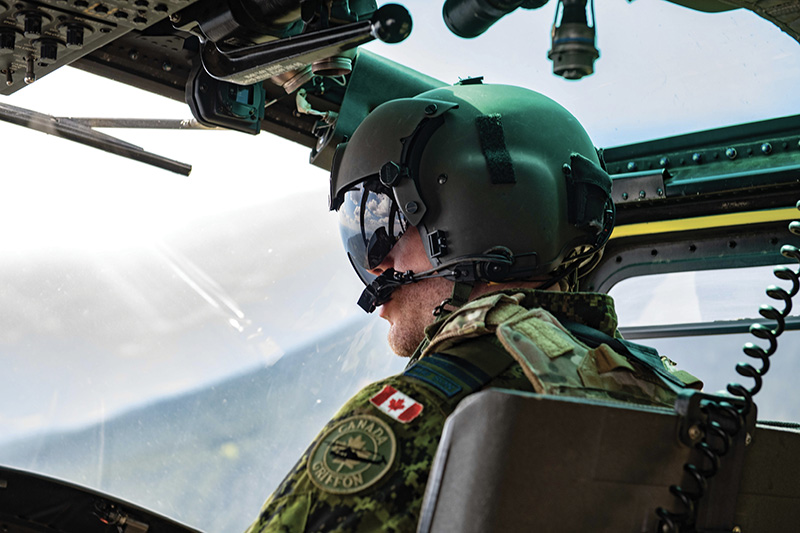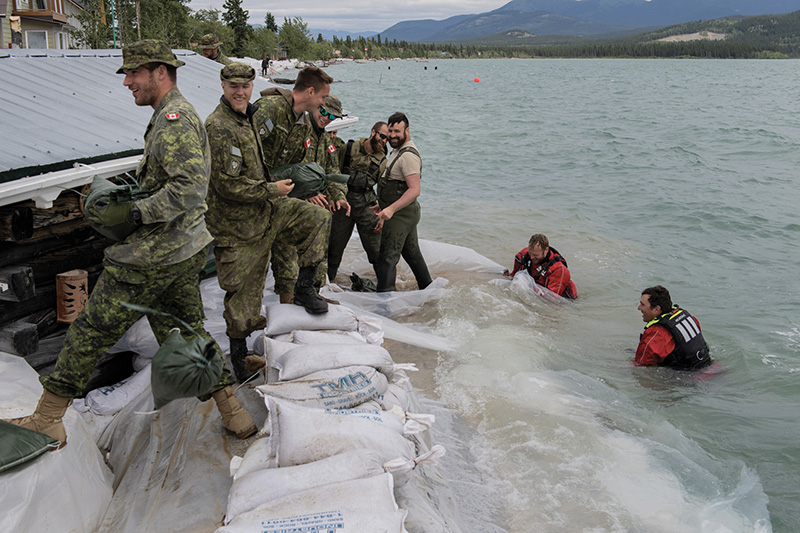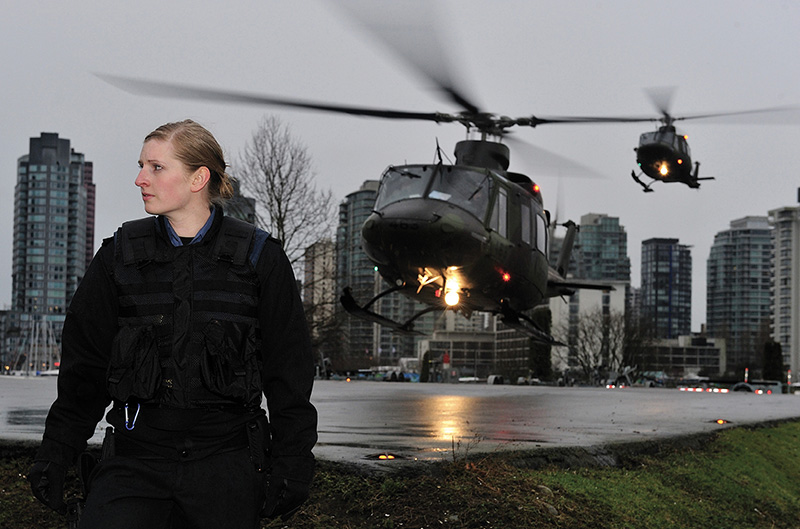
DND photo by Corporal Jay Naples
Pilot, Captain Tom Marks flies a CH-146 Griffon helicopter in the Kamloops region during Operation LENTUS, 21 July 2021.
In the Canadian Military Journal’s summer 2021 edition, Warrant Officer (WO) Ian Daniels has expressed his perspectives related to the Canadian military’s role. In Warrior Spirit, WO Daniels asserts that Canada’s military should be used for naught but winning Canada’s just wars. His argument indicates that other conflicts are outside the distinctive skillset of its soldiers: to close with and destroy the enemy. Operations other than war (OOTW) as a mission set, he opines, represent an ideology that conflicts with a soldier’s natural instincts. He posits that it is difficult for militaries to adapt their wartime roles to the realities of peace operations, and therefore for these reasons, Canada’s military should only be used for the most violent end of the conflict spectrum: war.
On the face of it, this assertion seems reasoned, and one can appreciate the sentiment behind it. If one were a fully qualified professional fire rescue specialist, one could become jaded if constantly called out to retrieve pets from trees with no fire in sight. It is generally agreed among professions that professionals should only be employed for their profession, and should not undertake work that the “… practitioner is not competent to perform by virtue of the practitioner’s training and experience.”Footnote 1 The Canadian military is considered a collective profession, responsive to the Government of Canada, with all its associated attributes and responsibilities.Footnote 2 So, should this generally accepted professional approach to accepting work not also apply to its soldiers?
The answer to this question is not that simple. The Canadian Armed Forces (CAF) serves Canadians through objectives assigned by the Canadian Government in the national interest. The CAF’s role is generally “…to apply force, or the threat of force, in the furtherance of the interests of the state.”Footnote 3 The government has expressed the CAF’s role clearly in its 2017 defence policy, Strong, Secure Engaged, with eight core missions, four concurrent operations, and nine potential deployments.Footnote 4 The majority of these objectives are OOTW. Moreover, the National Defence Act is clear in stipulating that all the “…regular force, all units and other elements thereof and all officers and non-commissioned members thereof are at all times liable to perform any lawful duty.”Footnote 5 So, though the CAF is a profession, its members are compelled by the National Defence Act to fulfill all lawful orders in the pursuit of duty. Their discretion to refuse assigned objectives is limited only to those that are manifestly unlawful. In practice, this translates into the CAF accepting all objectives assigned by the federal government, subject to mitigation through military advice. Hence, the military is employed in a wide range of security activities in the national interest.
Other factors militate against just using CAF members only for war. From the perspective of value for money, it seems highly inefficient to spend our current annual national defence budget of approximately $21.9 billionFootnote 6 to use the CAF solely for the next existential threat to Canada or one of our NATO collective defence Article 5 allies. The former last happened in 1939, and the latter in 2001. One could argue that Canadian forward defence in Europe during the Cold War served Canadian national interests as much as military deployments in Estonia, Latvia and the Ukraine do so today. None have yet to turn into a hot war.
One of Warrior Spirit’s assertions is that OOTW, including peacekeeping, are against a soldier’s instincts to close with and destroy the enemy, the official role of the infantry. One can agree that OOTW are often more cognitively demanding than war. Often, the opposing combatants do not wear uniforms and hide among the population, thereby increasing the risk of collateral civilian casualties and increasing challenges in finding, isolating, fixing, and striking the enemy. To add to this complexity, OOTW employ various and often restrictive rules of engagement that are tailored to the threat environment and type of mission. As an example, United Nations Chapter 6 “peacekeeping” missions employ more restrictive rules of engagement than United Nations Chapter 7 “peacemaking” missions. The challenges increase significantly when belligerents’ use of force transitions surprisingly from Chapter 6-like conditions to Chapter 7-like conditions, with a concomitant need for rapid change in United Forces force posture, mandate, and rules of engagement. The need for agility to rapidly switch between mandate and rules of engagement is one of the reasons why United Nation’s missions in the 1990s were so challenging.

DND photo by Corporal Rachael Allen
Soldiers from the 3rd Battalion, Princess Patricia’s Canadian Light Infantry pass sandbags down the chain to add to the wall during Operation LENTUS in Marsh Lake, Yukon, 11 July 2021.
Operation HARMONY and the 2 Princess Patricia’s Canadian Light Infantry Battle Group’s (2 PPCLI BG) operations in the Medak pocket area in September 1993 are probably the most emblematic and representative of this challenge. Whilst in the middle of a United Nations Chapter 6 mission, the belligerents rapidly escalated into full combat operations, requiring a rapid transition to Chapter 7-like rules of engagement for 2 PPCLI BG to fulfill its new mission; halt belligerent combat, and return them to pre-combat lines. Lieutenant-Colonel Calvin’s BG, despite a lack of United Nations’ direction, took initiative and did what was necessary to stop the Croat “ethnic cleansing” of civilian Serbs in the Medak area. 2 PPCLI BG’s combat performance was nothing less than exemplary. It was Canadian political election exigencies of the day which prevented this exceptional military operation from being recognized for many years, and which contributed to the mental and moral harm caused to 2 PPCLI BG’s soldiers.Footnote 7 The fact that the United Nations’ Chapter 6 mission caused so much harm was not attributed to the fact that it was the first major combat action since Canada’s involvement in the Korean conflict, but rather, the fact that the government did not recognize 2 PPCLI BG’s heroic actions for so long. And it was 2 PPCLI’s exhaustive and realistic live-fire war-fighting pre-deployment training, combined with an intent-based command and leadership approach in theatre that was key to their success in the Medak pocket.Footnote 8
Professional soldiers are trained to fulfill their primary occupational role, and such training is rightfully focused on the top end of the spectrum of conflict: warfighting. Prior to deploying operations other than war, or while deployed, soldiers need to be trained on theatre mission-specific tactics, techniques, and procedures, including rules of engagement. A soldier’s instincts are therefore not always to close with and destroy the enemy; a soldier’s instincts are what the soldier is trained to do for that mission. As a Greek soldier and philosopher once said about performing under pressure, “… [w]e do not rise to the level of our expectations, we fall to the level of our training.”Footnote 9 As long as soldiers are trained to perform their duties, they will perform them well, and in the crucible that was Medak, the 2PPCLI BG sunk to the level of its training. As an aside, probably the earliest account of this phenomenon of the Canadian soldier’s ability to adapt and sink to the level of their training while on operations is that of the Canadian Corps at Vimy in March and April of 1917.Footnote 10
Warrior Spirit’s insistence that CAF “…soldiers are trained to be warriors leaves little doubt that they are better suited to fight wars than to engage in peace operations for which they do not have the skills required…” manifestly underestimates the mental acuity and agility of those in uniform. Although they may be trained for warfighting, CAF personnel are highly capable at operating at many levels other than warfighting. In fact, the term warrior is too narrow a term to describe our people’s diverse talents.Footnote 11 Our people are much more capable than just warfighting. It would be more accurate to say that our sailors, soldiers, aviators, and special forces operators are all capable of full-spectrum operations. The majority of a person’s career is spent conducting various forms of military service beyond that of operations, let alone combat operations. Most recently, the CAF has supported long-term care facilities in the grip of the Covid-19 pandemic and contributed to vaccine roll-out. We have been there for Canadians in the ice storm of 1998, the Red River floods of 1997 and 2009, the hurricane Juan aftermath of 2003, the Toronto snowstorm of 1999, and the Vancouver Olympics and G8 Summit in 2010. Although many of these operations were far from warfighting, they remind Canadians of the excellent calibre of those in uniform, and that we are there to help those we serve in extremis.

DND photo by MCpl Chris Ward/ET2010-0015-82
Ordinary Seaman Aaricka Winlaw stands guard to ensure the safety of personnel in the vicinity of the helicopter landing pad, while two Canadian Forces CH-146 Griffin helicopters prepare to land at HMCS Discovery during Operation PODIUM.
Although one can appreciate Warrior Spirit’s desire for a simpler approach to military service, it does not stand up to considered thought. The sheer expense of a military that would only be employed to deter the threat of war or defend our national sovereignty is an untenable model for Canadians. It would require a standing military of considerable size at high levels of readiness. If the government wished to participate in OOTW, then it would have to develop another security organization to do so, and at considerable expense. Warrior Spirit’s perspective underestimates the ability of our service men and women to deliver excellence across a spectrum of conflict and all the rewards such rich and diverse employment brings to our people, and credit to our nation. Lastly, it forgets that CAF personnel can readily adapt to a change in mission in short order. One of the greatest strengths of the CAF is its rapid adaptability as evidenced in Medak, a testament to the versatility of CAF personnel and leadership. If one only identifies as a “warrior,” they would be better off releasing from the military to pursue a career as a mercenary, wherein they could choose the wars in which they wished to fight.
Lieutenant-Colonel (Ret’d) W.G. (Bill) Cummings, CD, is a highly-experienced infantry officer from The Royal Canadian Regiment. His 36 years of uniformed service includes operational tours in Cyprus, Bosnia and Afghanistan. Bill is currently employed as a civilian as the Senior Staff Officer Professional Concepts and Development at the Canadian Defence Academy in Kingston, Ontario.